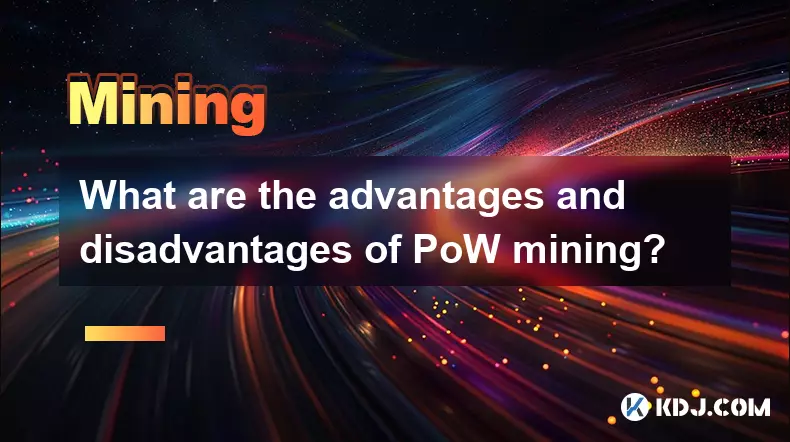-
 bitcoin
bitcoin $118548.520763 USD
3.67% -
 ethereum
ethereum $4352.564943 USD
4.79% -
 xrp
xrp $2.964058 USD
4.22% -
 tether
tether $1.000565 USD
0.05% -
 bnb
bnb $1028.372955 USD
1.46% -
 solana
solana $221.373507 USD
6.00% -
 usd-coin
usd-coin $0.999933 USD
0.02% -
 dogecoin
dogecoin $0.248633 USD
6.85% -
 tron
tron $0.341444 USD
2.38% -
 cardano
cardano $0.852946 USD
5.82% -
 hyperliquid
hyperliquid $47.869306 USD
6.15% -
 chainlink
chainlink $22.561476 USD
6.01% -
 ethena-usde
ethena-usde $1.001258 USD
0.05% -
 avalanche
avalanche $30.660000 USD
2.06% -
 stellar
stellar $0.400917 USD
9.76%
What are the advantages and disadvantages of PoW mining?
Proof-of-work ensures blockchain security through decentralized mining, though high energy use and centralization risks remain key challenges.
Sep 21, 2025 at 09:54 pm

Advantages of Proof-of-Work Mining
1. Decentralization is preserved through distributed mining participation, allowing anyone with hardware to contribute to network security.
2. The competitive nature of PoW incentivizes miners to invest in efficient equipment and infrastructure, leading to continuous technological improvements in computing power.
3. Transaction validation is secured by cryptographic puzzles that require substantial computational effort, making it extremely costly for attackers to manipulate the blockchain.
4. The transparency of the mining process ensures that all participants can verify block creation and reward distribution independently.
5. Network consensus is achieved without relying on a central authority, reinforcing trustlessness and reducing single points of failure.
Disadvantages of Proof-of-Work Mining
1. High energy consumption associated with mining operations raises environmental concerns and increases operational costs.
2. The concentration of mining power in large pools located in regions with cheap electricity undermines the ideal of full decentralization.
3. Expensive and specialized hardware like ASICs creates barriers to entry for individual miners, favoring well-capitalized entities.
4. Block times are inherently slower due to the time required to solve complex mathematical problems, limiting transaction throughput.
5. The risk of 51% attacks, although rare, remains present, especially on smaller networks where hash power can be rented or accumulated.
Economic Implications of PoW Mining
1. Miners are rewarded with newly minted coins and transaction fees, creating a built-in economic model that supports long-term network sustainability.
2. The halving events in networks like Bitcoin reduce block rewards over time, introducing scarcity and influencing market dynamics.
3. Fluctuations in cryptocurrency prices directly affect mining profitability, leading to periods of rapid expansion or shutdown of mining farms.
4. Countries with low electricity costs become hotspots for mining activity, often prompting regulatory scrutiny and policy changes.
5. Secondary markets for used mining equipment emerge during bear markets, creating new opportunities and challenges in hardware lifecycle management.
Security Mechanisms in PoW Systems
1. The immutability of the blockchain is enforced by the cumulative work required to alter previous blocks, making historical tampering impractical.
2. Difficulty adjustments ensure consistent block generation intervals despite changes in total network hash rate.
3. Each new block strengthens the security of prior transactions, exponentially increasing the cost of reversing confirmed transfers.
4. Peer-to-peer propagation of blocks allows rapid detection of invalid chains, enabling nodes to reject fraudulent attempts quickly.
5. Incentive alignment ensures that honest mining yields greater financial returns than attempting double-spends or chain reorganizations.
Frequently Asked Questions
What prevents miners from cheating in a PoW system?Miners must broadcast their solutions to the network, where other nodes validate the proof before accepting the block. Invalid blocks are rejected, and the miner loses potential rewards and wastes computational resources.
Why do some cryptocurrencies move away from PoW?Many projects transition to alternatives like Proof-of-Stake to reduce energy usage, increase transaction speed, and lower the barrier to participation while maintaining security through different mechanisms.
How does mining difficulty affect small-scale operators?As difficulty rises, small miners may struggle to compete with industrial-scale farms. This often leads them to join mining pools to combine hashing power and receive proportional rewards.
Can renewable energy solve PoW’s environmental issues?Using solar, wind, or hydroelectric power for mining reduces carbon footprint significantly. Several mining operations now prioritize green energy sources to align with sustainability goals and improve public perception.
Disclaimer:info@kdj.com
The information provided is not trading advice. kdj.com does not assume any responsibility for any investments made based on the information provided in this article. Cryptocurrencies are highly volatile and it is highly recommended that you invest with caution after thorough research!
If you believe that the content used on this website infringes your copyright, please contact us immediately (info@kdj.com) and we will delete it promptly.
- BlockDAG, DOGE, HYPE Sponsorship: Crypto Trends Shaping 2025
- 2025-10-01 00:25:13
- Deutsche Börse and Circle: A StableCoin Adoption Powerhouse in Europe
- 2025-10-01 00:25:13
- BlockDAG's Presale Buzz: Is It the Crypto to Watch in October 2025?
- 2025-10-01 00:30:13
- Bitcoin, Crypto, and IQ: When Genius Meets Digital Gold?
- 2025-10-01 00:30:13
- Stablecoins, American Innovation, and Wallet Tokens: The Next Frontier
- 2025-10-01 00:35:12
- NBU, Coins, and Crypto in Ukraine: A New Yorker's Take
- 2025-10-01 00:45:14
Related knowledge

The difference between staking and mining
Sep 24,2025 at 05:18am
Understanding Staking in the Cryptocurrency Ecosystem1. Staking involves holding funds in a cryptocurrency wallet to support the operations of a block...

How to participate in testnet mining?
Sep 22,2025 at 09:18am
Understanding Testnet Mining in the Crypto Ecosystem1. Testnet mining is a method used by blockchain developers to simulate real-world conditions on a...

How to dispose of abandoned mining machines?
Sep 19,2025 at 08:19pm
Assessing the Condition of Abandoned Mining Rigs1. Begin by inspecting each mining machine for visible damage, corrosion, or missing components. Machi...

How to identify high-quality mining pools?
Sep 21,2025 at 03:19pm
Reputation and Track Record1. A mining pool’s reputation is built over time through consistent performance and transparency. Pools that have operated ...

Advantages of decentralized mining pools
Sep 20,2025 at 04:36pm
Enhanced Security and Resistance to Censorship1. Decentralized mining pools operate on blockchain-based smart contracts, eliminating the need for a ce...

What is mining machine overclocking?
Sep 21,2025 at 07:19pm
Understanding Mining Machine Overclocking1. Mining machine overclocking refers to the process of increasing the operating frequency of a cryptocurrenc...

The difference between staking and mining
Sep 24,2025 at 05:18am
Understanding Staking in the Cryptocurrency Ecosystem1. Staking involves holding funds in a cryptocurrency wallet to support the operations of a block...

How to participate in testnet mining?
Sep 22,2025 at 09:18am
Understanding Testnet Mining in the Crypto Ecosystem1. Testnet mining is a method used by blockchain developers to simulate real-world conditions on a...

How to dispose of abandoned mining machines?
Sep 19,2025 at 08:19pm
Assessing the Condition of Abandoned Mining Rigs1. Begin by inspecting each mining machine for visible damage, corrosion, or missing components. Machi...

How to identify high-quality mining pools?
Sep 21,2025 at 03:19pm
Reputation and Track Record1. A mining pool’s reputation is built over time through consistent performance and transparency. Pools that have operated ...

Advantages of decentralized mining pools
Sep 20,2025 at 04:36pm
Enhanced Security and Resistance to Censorship1. Decentralized mining pools operate on blockchain-based smart contracts, eliminating the need for a ce...

What is mining machine overclocking?
Sep 21,2025 at 07:19pm
Understanding Mining Machine Overclocking1. Mining machine overclocking refers to the process of increasing the operating frequency of a cryptocurrenc...
See all articles










































































